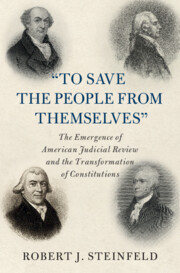 'To Save the People from Themselves'
'To Save the People from Themselves' Book contents
- “To Save the People from Themselves”
- Cambridge Historical Studies in American Law and Society
- “To Save the People from Themselves”
- Copyright page
- Dedication
- Contents
- Acknowledgments
- Introduction
- Part One Legislatures and Legislation under the First American Constitutions
- Part Two The Emergence of American Judicial Review: 1779–1787
- I The Emergence of American Judicial Review, 1779–1782
- II The Emergence of American Judicial Review, 1784–1787: Developing Judicial Review as a Check on Legislatures and on the People
- 6 The Reappearance of “Vertical” Judicial Review in the Case of Rutgersv.Waddington, New York, 1784
- 7 The Successful Battle to Establish Judicial Review in New Hampshire: The Ten Pound Act Cases, 1786–1787, and Their Aftermath
- 8 Judicial Review and Legislative Supremacy in Rhode Island: The Case of Trevett v. Weeden, 1786, and Its Aftermath
- 9 The Struggle Between Traditional Constitutionalism and the Constitution of Judicial Review in North Carolina: The Case of Bayard v. Singleton, 1786–1787, and Its Aftermath
- Part Three Judicial Review at the Federal Convention
- Index
7 - The Successful Battle to Establish Judicial Review in New Hampshire: The Ten Pound Act Cases, 1786–1787, and Their Aftermath
from II - The Emergence of American Judicial Review, 1784–1787: Developing Judicial Review as a Check on Legislatures and on the People
Published online by Cambridge University Press: 17 September 2021
- “To Save the People from Themselves”
- Cambridge Historical Studies in American Law and Society
- “To Save the People from Themselves”
- Copyright page
- Dedication
- Contents
- Acknowledgments
- Introduction
- Part One Legislatures and Legislation under the First American Constitutions
- Part Two The Emergence of American Judicial Review: 1779–1787
- I The Emergence of American Judicial Review, 1779–1782
- II The Emergence of American Judicial Review, 1784–1787: Developing Judicial Review as a Check on Legislatures and on the People
- 6 The Reappearance of “Vertical” Judicial Review in the Case of Rutgersv.Waddington, New York, 1784
- 7 The Successful Battle to Establish Judicial Review in New Hampshire: The Ten Pound Act Cases, 1786–1787, and Their Aftermath
- 8 Judicial Review and Legislative Supremacy in Rhode Island: The Case of Trevett v. Weeden, 1786, and Its Aftermath
- 9 The Struggle Between Traditional Constitutionalism and the Constitution of Judicial Review in North Carolina: The Case of Bayard v. Singleton, 1786–1787, and Its Aftermath
- Part Three Judicial Review at the Federal Convention
- Index
Summary
In the years immediately following the end of the Revolutionary War, the united states experienced a severe economic downturn, brought on by a variety of causes, that included British commercial retaliation, a collapse in domestic demand following the end of fighting, the flight of hard currency abroad, and a large increase in state taxes to pay off the war debt.1 “Per capita gross national product plummeted nearly 50 percent in the fifteen years after Americans declared independence.”2 In response to these hard economic times, a number of states enacted debtor relief legislation of various kinds, which became, along with anti-Loyalist laws, the second major impetus for the further development of judicial review.
- Type
- Chapter
- Information
- 'To Save the People from Themselves'The Emergence of American Judicial Review and the Transformation of Constitutions, pp. 260 - 298Publisher: Cambridge University PressPrint publication year: 2021
